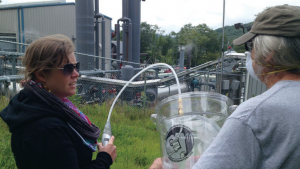A paper published today in Environmental Health has raised concerns about air quality in areas surrounding oil and gas operations, including hydraulic fracturing (fracking) sites. Caroline Cox, an author on the paper, is Research Director for the Center for Environmental Health, a US nonprofit working to end health threats from toxic chemicals in air, water, food, and the products we use every day. Here she tells us more about what their new study has found.
Decades ago, when I was a graduate student, my advisor often said that our job as scientists was to put numbers on the obvious. Maybe it should be obvious that oil and gas production, including as it does the extraction, transport, and processing of enormous quantities of hydrocarbon mixtures, will result in air pollution, but studies that put numbers on this pollution have been rare.
The complexities of topography, weather, and the variability in the production processes themselves make such studies difficult. Today Environmental Health publishes a new study that “puts numbers” on air pollution near oil and gas infrastructure in five US states and finds sobering results.
The Environmental Health study is a collaboration between 15 local, state, and national nonprofit organizations. Our groups came together to conduct this study because we all share concerns about the potential but little studied health threats from the expansion of oil and gas operations, and in particular from hydraulic fracturing (fracking).

Our study is an example of community based participatory research: the health concerns experienced by the local partners in the study were the impetus for the research. The local partners were trained to collect air samples and used their knowledge of local conditions to determine where and when to take the air samples.
About 40% of the samples we took contained at least one chemical at concentrations that exceeded risk levels established by either of two U.S. agencies, the US Environmental Protection Agency and the Agency for Toxic Substances and Disease Registry (ATSDR).
Concentrations of eight different volatile chemicals in samples from four of the five states studied exceeded these standards. The chemicals which most frequently exceeded the risk levels were benzene and formaldehyde, both known carcinogens, and hydrogen sulfide, which can cause dizziness, sore throat, labored breathing, and unconsciousness. Some of the pollution levels measured were extraordinary: for example one site found benzene at levels that were 12,000 times the safety level established by ATSDR.
Our results may surprise those who have heard claims that natural gas from fracking is a cleaner ‘bridge fuel’ to a climate friendly future. Our results suggest that oil and gas operations may not be as clean as advertised, and could pose unaddressed health risks to neighboring communities.
Given the gaps in air quality research around oil and gas operations, those of us who helped with the study hope that it will encourage more extensive future research, especially that which uses the expertise of local communities. We also hope that it will spur more robust air pollution monitoring by government agencies, more disclosure about the chemicals used in oil and gas production, a precautionary approach to new oil and gas development, and increased investments in energy efficiency and renewable energy.
Comments